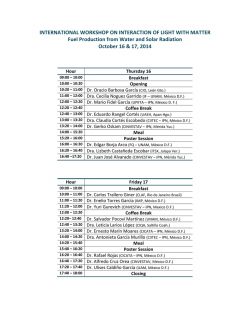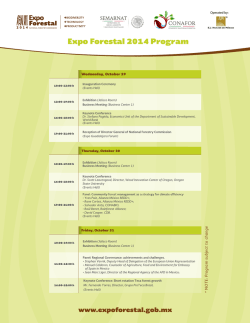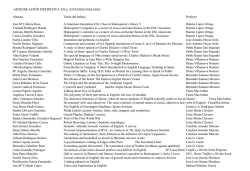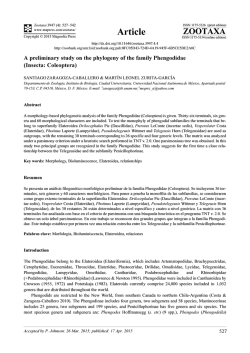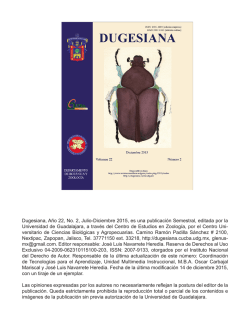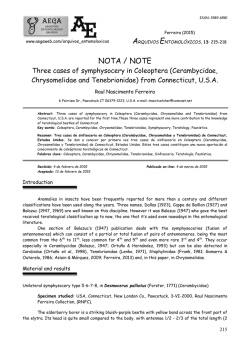
Coleoptera, Staphylinidae, Proteininae
Zootaxa 3918 (4): 594–598 www.mapress.com /zootaxa / Copyright © 2015 Magnolia Press ISSN 1175-5326 (print edition) Correspondence ZOOTAXA ISSN 1175-5334 (online edition) http://dx.doi.org/10.11646/zootaxa.3918.4.9 http://zoobank.org/urn:lsid:zoobank.org:pub:616E9E10-29F6-4690-B02E-CC1922BD7BF6 A new Mexican species of Megarthrus Curtis (Coleoptera, Staphylinidae, Proteininae) WILLIAM DAVID RODRÍGUEZ1 & JOSÉ LUIS NAVARRETE-HEREDIA2 Entomología, Centro de Estudios en Zoología, CUCBA, Universidad de Guadalajara, Apartado Postal 134, 45100 Zapopan, Jalisco, México. E-mail: [email protected]; [email protected] The genus Megarthrus Curtis with about 140 species described, is the largest of the subfamily Proteininae (Coleoptera: Staphylinidae) (Cuccodoro 2011; López-García et al. 2011). It is distributed worldwide (Cuccodoro 1999) and has an amphipolar distribution, being more diverse in Holarctic region (Newton 1985). In the tropics, the ecological requirements of Megarthrus species restrict their presence to mountain areas, showing high levels of endemism, making a taxon potentially informative for biogeographic analysis (Cuccodoro 1998). In Mexico there was only one described species: Megarthrus altivagans Bernhauer, 1929, but it is known that there are several undescribed species (NavarreteHeredia et al. 2002). Cuccodoro (2011), recognised “eleven species from Mexico, eleven species from Costa Rica, Guatemala, Honduras, Nicaragua and Panama, and fifteen species from Bolivia, southern Brazil, Colombia, Ecuador, Peru and Venezuela”. In this paper we describe a new species of Mexican Megarthrus from the State of Jalisco. Measurements are in millimeters (mm) and were abbreviated as follows: PL—length of pronotum at midline; EL— length of elytra at midline. Terms for morphological characters and definitions mainly follow Cuccodoro (2011). Specimens examined are deposited in the following collections: Colección Entomológica, Centro de Estudios en Zoología, Universidad de Guadalajara, Jalisco, México (CZUG), Colección Nacional de Insectos, Instituto de Biología Universidad Nacional Autónoma de México, México (CNIN), Colección Entomológica, Universidad Distrital Francisco José de Caldas, Bogotá, Colombia (MUD) and Muséum d'histoire naturelle, Geneva, Switzerland (MHNG). Megarthrus alatorreorum sp nov. Holotype ♂. MÉXICO, JAL: Teocuitatlán de Corona, Cerro de García, NTP-12. Calamar. 7. VI- 2.VII.2014, 20°10´8.16” N 103°20´51.78”W, 2775 msnm, Col. William D. Rodríguez, (CZUG). Paratypes (28) MÉXICO, JAL: Teocuitatlán de Corona, Cerro de García, NTP-12. Calamar. 7. VI–2.VII.2014, 20°10´8.16” N 103°20´51.78”W, 2775 msnm. Col. William D. Rodríguez (1♂ 3♀: CZUG); MÉXICO, JAL: Teocuitatlán de Corona, Cerro de García, NTP-12. Calamar. 7. VI–2.VII.2014, 20°10´8.16” N 103°20´51.78”W, 2775 msnm. Col. William D. Rodríguez (1♂ CZUG); MÉXICO, JAL: Teocuitatlán de Corona, Cerro de García, NTP-11. Calamar. 2. VII- 3 VIII. 2014, 20°10´8.94” N 103° 20´53.76”W, 2776 msnm. Col. William D. Rodríguez (1♀: CZUG); MÉXICO, JAL: Teocuitatlán de Corona, Cerro de García, NTP-80-10. Calamar. 2-VII al 3-VIII de 2014, 20°10´9.54” N 103° 20´51.72”W, 2774 msnm. Col. William D. Rodríguez. (1♀: CZUG); MÉXICO, JAL: Teocuitatlán de Corona, Cerro de García, NTP-80-12. Calamar. 7-VI al 2-VII de 2014, 20°10´8.16” N 103°20´51.78”W, 2775 msnm. Col. William D. Rodríguez. (1♀: CZUG); MÉXICO: JAL, Teocuitatlán de Corona, Cerro de García, NTP-80-09-Calamar. 28-IX/31-X de 2013,20°10´7.5” N 103°20´22.2”W, 2623 msnm. Col. William D. Rodríguez. (1♂ CNIN); MÉXICO: JAL, Teocuitatlán de Corona, Cerro de García, NTP-80-07. Calamar. 7-VI al 2-VII de 2014, 20°10´3.78” N 103°20´27.12”W, 2623 msnm. Col. William D. Rodríguez. (1♀ CNIN); MÉXICO: JAL, Teocuitatlán de Corona, Cerro de García, NTP-80-12. Calamar. 4 - V al 7 - VI de 2014, 20°10´8.16” N 103°20´51.78”W, 2775 msnm. Col. William D. Rodríguez. (1♀ CNIN); MÉXICO: JAL, Teocuitatlán de Corona, Cerro de García, NTP-80-09. Calamar. 2-VII al 3-VIII de 2014, 20°10´7.5” N 103°20´22.2”W, 2623 msnm. Col. William D. Rodríguez. (2♀ CNIN); MÉXICO: JAL, Teocuitatlán de Corona, Cerro de García, NTP-80-09. Calamar. 3-VIII al 3 IX de 2014, 20°10´7.5” N 103°20´22.2”W, 2623 msnm. Col. William D. Rodríguez. (1♀ CNIN); MÉXICO: JAL, Teocuitatlán de Corona, Cerro de García, NTP-80-09. Calamar. 2-VII al 3-VIII de 2014, 20°10´7.5” N 103°20´22.2”W, 2623 msnm. Col. William D. Rodríguez. (1♂ MUD); MÉXICO: JAL, Teocuitatlán de Corona, Cerro de García, NTP-8012. Calamar. 4 - V al 7 - VI de 2014, 20°10´8.16” N 103°20´51.78”W, 2775 msnm. Col. William D. Rodríguez. (1♂ 594 Accepted by J. Klimaszewski: 16 Jan. 2015; published: 13 Feb. 2015 Licensed under a Creative Commons Attribution License http://creativecommons.org/licenses/by/3.0 Lamiaceae (Salvia gesneriflora, Salvia iodantha and Salvia elegans), Primulaceae (Anagallis arvensis), Fagaceae (Quercus crassipes), Verbenaceae (Lippia spp.), Amaranthaceae (Iresine spp.), Onagraceae (Lopezia spp. and Fuchsia spp.) and Asteraceae (Verbesina spp.). Specimens were collected between 2400–2800 masl with carrion traps baited with squid. Although the species has been collected only with carrion traps we assume that it is not a carrion feeder but a saprophagous species, as other species in this genus. Mushrooms, fruits and other organic matter at decomposing stages might attract more specimens. The minimun temperature of the habitat was 12°C, mean 19.93 °C and a maximum of 29.5 °C, the minimum relative humidity was 24%, mean 68.5% and a maximum of 89%. The mean rainfall was 6.7 mm/month. Remarks. Megarthrus alatorreorum, M. altivagans and M. ashei Cuccodoro & Löbl, 1996 (from Arizona and New Mexico) are the only New World members of the genus to possess an asymmetrical aedeagal valve in combination with prohypomera lacking discal ridge.Among these species M. alatorreorum and M. altivagans uniquely share a modified frons in the male, but M. altivagans lacks a medio-apical projection on abdominal tergite VIII in the female. The aedeagal shape is also diagnostic. Acknowledgments The authors thanks the National Council for Science and Technology (CONACYT) Mexico, through a postgraduate scholarship 554194/300885 and to the program in Biosystematics and Management of Natural and Agriculture Resources (BIMARENA). We also thank Dr. Giulio Cuccodoro (Muséum d'Histoire Naturelle, Genève), for his contributions to this work and to Dr. Pablo Carrillo Reyes (University of Guadalajara) for the determination of plant species. Literature cited Bernhauer, M. (1929) Neue Staphyliniden aus Mittelamerika. Wiener Entomologische Zeitung, 46, 186–208. Cuccodoro, G. (1998) Revision and phylogeny of Megarthrus Curtis 1829 from New Guinea, New Caledonia and Fiji (Coleoptera Staphylinidae Proteininae). Tropical Zoology, 11, 103–137. Cuccodoro, G. (1999) Four new species of Megarthrus Curtis, 1829 (Coleoptera, Staphylinidae, Proteininae) from the Bale Mountains, southern Ethiopia. Bulletin de la Société entomologique suisse, 72, 373–386. Cuccodoro, G. (2011) Revision of the Neotropical types of Megarthrus Curtis, 1829 and description of two new species from Costa Rica and Peru (Coleoptera, Staphylinidae, Proteininae). Revue Suisse de Zoologie, 118 (1), 107–147. Cuccodoro, G. & Löbl, I. (1996) Revision of the rove beetles of the genus Megarthrus of America north of Mexico (Coleoptera: Staphylinidae: Proteininae). Mitteilungen der Münchner Entomologischen Gesellschaft, 86, 145–188. Curtis, J. (1829) A guide to an arrangement of British Insects: being a catalogue of all the named species hitherto discovered in Great Britain and Ireland. Westley & Davis, London, 332 pp. López-García, M.M., Méndez-Rojas, D.M. & Navarrete-Heredia, J.L. (2011) First record and a new species of Megarthrus Curtis (Coleoptera, Staphylinidae, Proteininae) from the Colombian Central Andes. Zootaxa, 2916 (1), 62–64 Navarrete-Heredia, J.L., Newton, A.F., Thayer, M.K., Ashe, J.S. & Chandler, D.S. (2002) Guía ilustrada para los géneros de Staphylinidae (Coleoptera) de México. Illustrated guide to the genera of Staphylinidae (Coleoptera) of México. Universidad de Guadalajara y Conabio, México, 401 pp. Newton, A.F. Jr. (1985) South temperate Staphylinoidea (Coleoptera): their potential for biogeographic analysis of austral disjunctions. In: Ball, G.E. (Ed.), Taxonomy, Phylogeny and Zoogeography of Beetles and Ants. Series Entomologica 33. W. Junk, Dordrecht, pp. 179–220. 598 · Zootaxa 3918 (4) © 2015 Magnolia Press RODRÍGUEZ & NAVARRETE-HEREDIA
© Copyright 2025
